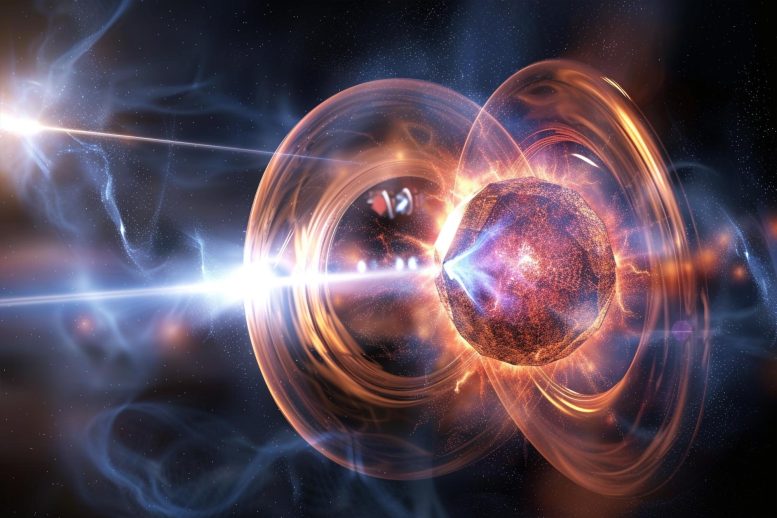
By Anne J. Manning, Harvard University October 22, 2024
Collected at: https://scitechdaily.com/precision-redefined-harvards-spin-squeezing-enhances-quantum-sensing/
New research at Harvard has enhanced quantum sensors’ capabilities through spin squeezing, a method that fine-tunes measurement sensitivity.
This breakthrough could lead to significant improvements in technologies ranging from biomedical imaging to atomic clocks.
Exploring Quantum Sensing Breakthroughs
Measurement is fundamental to every achievement and discovery in science. Today, thanks to advancements in quantum sensing, scientists can now measure phenomena that were once unimaginable—such as the vibrations of atoms, the properties of individual photons, and the subtle fluctuations associated with gravitational waves.
One promising quantum technique, known as “spin squeezing,” has the potential to greatly enhance the precision of quantum sensors. However, it has been notoriously difficult to achieve. In new research, Harvard physicists have brought spin squeezing closer to practical use.
Spin squeezing is a form of quantum entanglement that limits how much a group of particles can fluctuate. This restriction allows for more precise measurements of certain signals, although it comes at the cost of reduced accuracy for other complementary measurements. It’s similar to squeezing a balloon—gaining height by losing width.

Enhancing Measurement Precision Through Quantum Mechanics
“Quantum mechanics can enhance our ability to measure very small signals,” said Norman Yao, a physics professor and author of the new paper on spin squeezing in Nature Physics. “We have shown that it is possible to get such quantum-enhanced metrology in a much broader class of systems than was previously thought.”
In the balloon metaphor, a circle represents the uncertainty intrinsic to any quantum measurement, explained Maxwell Block, co-author of the paper and a former Griffin Graduate School of Arts and Sciences student. “By squeezing this uncertainty, making the balloon more like an ellipse, one can reshape the sensitivity of measurements,” Block said. “This means that certain measurements can be more precise than anything one could possibly do without quantum mechanics.”
An analog of spin squeezing was used, for example, to increase the sensitivity of the Nobel-garnering gravitational wave detectors in the LIGO experiment.
New Strategies for Quantum Enhancements
The Harvard team’s work built upon a landmark 1993 paper that first described the possibility of a spin-squeezed, entangled state brought about by “all-to-all” interactions between atoms. Such interactions are akin to a large Zoom meeting, in which each participant is interacting with every other participant at once. Between atoms, this type of connectivity easily enables the build-up of the quantum mechanical correlations necessary to induce a spin-squeezed state. However, in nature, atoms typically interact in a way that’s more like a game of telephone, only speaking with a few neighbors at a time.
“For years, it has been thought that one can only get truly quantum-enhanced spin squeezing via all-to-all interactions,” said Bingtian Ye, co-lead author of the paper and also a former Griffin Graduate School of Arts and Sciences student. “But what we have shown is that it is actually way easier.”
In their paper, the researchers outline a new strategy for generating spin-squeezed entanglement. They intuited, and together with collaborators in France quickly confirmed via experiment that the ingredients for spin squeezing are present in a ubiquitous type of magnetism found often in nature — ferromagnetism, which is also the force that makes refrigerator magnets stick. They posit that all-to-all interactions are not necessary to achieve spin squeezing, but rather, so long as the spins are connected well enough to sync into a magnetic state, they should also be able to dynamically generate spin squeezing.
Future Directions in Quantum Sensing
The researchers are optimistic that by thus lowering the barrier to spin squeezing, their work will inspire new ways for quantum scientists and engineers to create more portable sensors, useful in biomedical imaging, atomic clocks, and more.
In that spirit, Yao is now leading experiments to generate spin-squeezing in quantum sensors made out of nitrogen-vacancy centers, which are a type of defect in the crystal structure of diamond that have long been recognized as ideal quantum sensors.
Reference: “Scalable spin squeezing from finite-temperature easy-plane magnetism” by Maxwell Block, Bingtian Ye, Brenden Roberts, Sabrina Chern, Weijie Wu, Zilin Wang, Lode Pollet, Emily J. Davis, Bertrand I. Halperin and Norman Y. Yao, 29 July 2024, Nature Physics.
DOI: 10.1038/s41567-024-02562-5

Leave a Reply